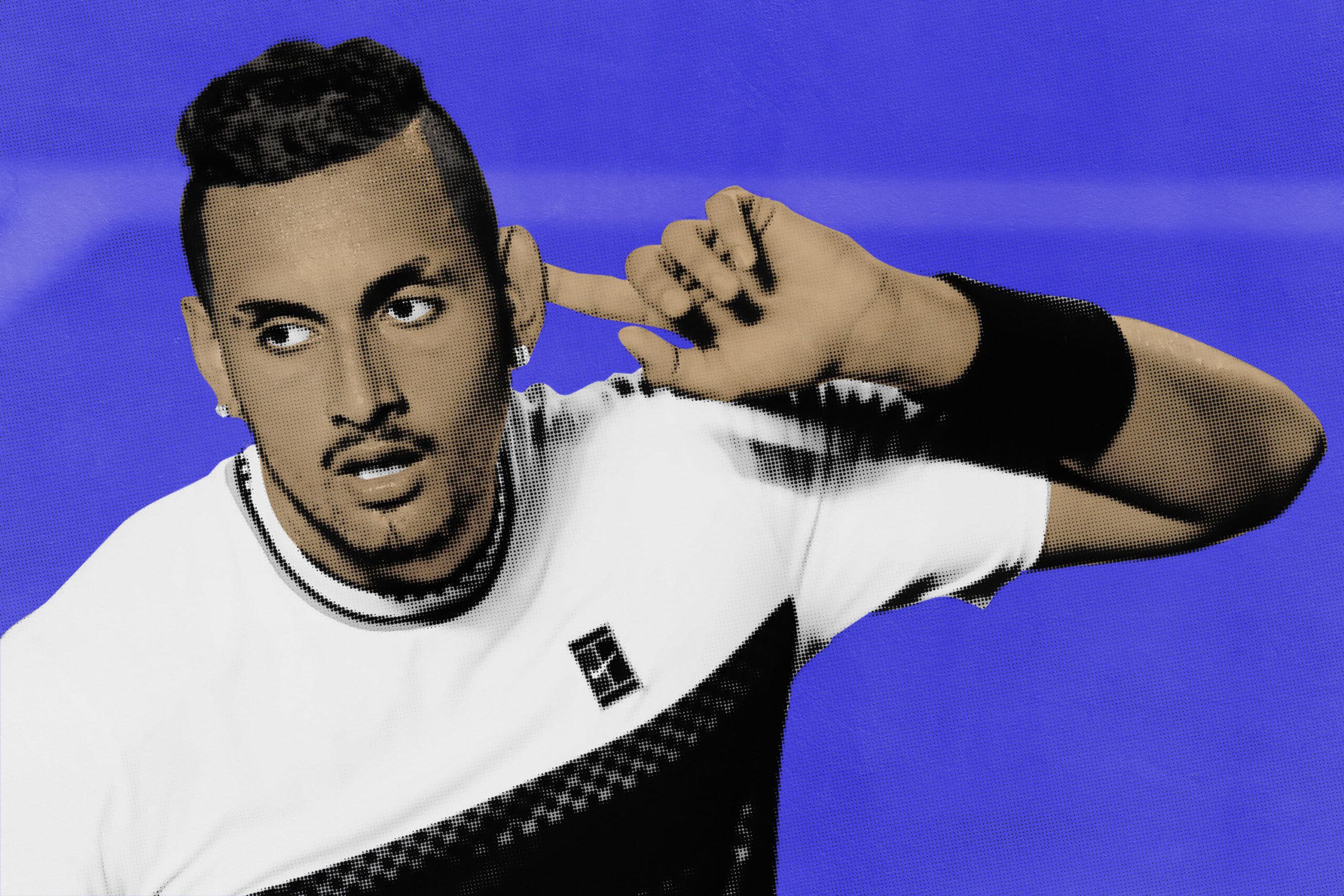Nick Kyrgios’s Latest Act of Rebellion: Winning a Tennis Tournament
The 23-year-old Australian is a prodigy and a provocateur; an incredibly gifted player who is also a tireless innovator in the craft of mass irritation. His talents were on full display during his ATP tour win last weekend.
Nick Kyrgios is a 23-year-old Australian tennis player who seems to have been designed in a laboratory for the sole purpose of driving people crazy. Kyrgios is very good at tennis—in 2018, John McEnroe called him the most talented player he’d seen in the past 10 years—but when it comes to driving people wild, he is breathtakingly, transcendently great. He is maddening in ways they never anticipated, along vectors they’ve never seen; he is a tireless innovator in the craft of mass irritation. He can cause fans to go absolutely nuts whether he wins or loses. McEnroe himself has spent a good chunk of the past five years complaining about Kyrgios, and McEnroe is probably the greatest tennis player of all time at driving people wild. Being found intensely annoying by John McEnroe is a high honor for any exasperating person. It’s like Beethoven humming your melody.
Last weekend this full-bore provocation opera was on spectacular display in Acapulco, where Kyrgios won his fifth professional tournament at the Mexican Open. During a week in which Roger Federer won his 100th ATP title (the Dubai Tennis Championships, so basically his home court), Kyrgios overshadowed everything else in the sport. Under a roar of boos, he played some of the most inspired tennis of his career. He also managed to drive people more completely around the bend than he has since the ATP suspended him for 28 days for a lewd comment he made to Stan Wawrinka during a televised match in 2015.
Against Rafa Nadal, the tournament’s top seed, in the round of 16 last Wednesday, Kyrgios nearly retired with a back injury. A microphone caught him telling a trainer that he was continuing only because the media would have a fit if he didn’t. Then he tried an underarm serve, a move that’s widely (if somewhat inanely) seen as unsportsmanlike in tennis. He provoked Nadal, who is usually unflappable to a degree that verges on the eerie, to snipe at him at the net. He cupped his hand behind his ear to make the crowd boo louder. After losing the first set 3-6, Kyrgios somehow managed to eke out the next two in tiebreaks, 7-6 (2), 7-6 (6). In the third set, he saved three match points. Afterward, Nadal, who never criticizes opponents, told the press that Kyrgios “lacks respect for the public, the rival, and toward himself.” Meanwhile, Kyrgios went online to argue in Facebook comments against people who thought the underarm serve was a dirty play.
In his next match, against his old nemesis Wawrinka, Kyrgios played smart, patient tennis, sprayed supersonic forehand winners to every quadrant of the court, and was booed so furiously that you started to worry oxygen-starved fans were going to black out in the aisles and have to be stretchered out by medical personnel. It was like Beatlemania as planned by the angel of death. Kyrgios won 7-5, 6-7 (3), 6-4. In the semifinals against John Isner, one of the hardest-serving players on the men’s tour, Kyrgios had a break point at 5-all in the first set. Instead of putting his head down and preparing for the 140 mph thunderbolt he was about to face, Kyrgios turned to the crowd. “Where are the Rafa fans at?” he yelled. “Hey Rafa fans, where you at? Let’s get a flight to Indian Wells”—the next big tournament Nadal will play in after Kyrgios sent him home from Mexico. The crowd chanted Isner’s name, and it did not go unnoticed on Twitter that Kyrgios had just made a stadium full of Mexican sports fans cheer for a Trump supporter.
After a bone-melting 7-5, 5-7, 7-6 (7) win (almost literally bone-melting: He suffered from knee issues, illness, and cramps throughout the tournament), Kyrgios used his victory speech to taunt his friend Isner. “I was pumped to play John because I knew I wouldn’t need to run much,” he said.
The final, against the second-seeded Alexander Zverev, was relatively quiet—or as quiet as a match can be when the boo decibels are at airport-runway levels—but by that point Kyrgios seemed to be enraging the world just by breathing. His fingernails seemed defiant. If you could have zoomed in on his cells, they would have been holding little signs saying, “this is funny” and “but seriously, fuck you.” He upset Zverev, 6-3, 6-4; when Zverev teased him after the match for not having a coach or much of a team around him, it might have been the first instance in history of a player trolling a crowd via the act of being trolled himself. I don’t have a team … but look who just won your tournament. Where are the Rafa fans at?
Later, Golf Digest wrote (admiringly!) that he might be on track to become the most hated athlete in sports.
For me, Kyrgios’s win at the Mexican Open was a dizzying reminder of how perfectly he is tuned to drive me, personally, wild. Not because I mind tennis players who act like bratty geniuses. Generally, I’m quite fond of them. As a sportswriter, I’ve spent a lot of time arguing that character, style, and experience are more interesting to think about than winning, structure, and process, and during the first few years of Kyrgios’s career, I thought I’d found my ideal star. At his best, Kyrgios plays with a kind of restless, sped-up hunger that’s unique in men’s tennis; I remember going to his U.S. Open matches when he was 19 years old and thinking I’d never experienced an energy like the one he brought to the court. Everything crackled, and the lights seemed brighter. My heart rate didn’t come down even during commercial breaks (which are intensely boring in tennis stadiums; you mostly sit there watching the players sip modestly from water bottles while “I Love It” by Icona Pop plays at moderate volume). He was a jolt to the head who seemed to have only intermittent interest in winning and no interest at all in tennis tradition. Perfect, I thought—winning and tradition are overrated. I wrote a lot of columns calling him, like, “the dark angel of chaos” or, I don’t know, “a thousand-foot cyclone of atomic flame on a mission to reforge the universe” (I have an enthusiastic and not very responsible brain).
A funny thing about sports, though, is that if you decide you think winning is unimportant, you might find yourself rooting for a magnificently gifted athlete who also thinks winning is unimportant. You might find that instead of being the liberating adventure of pure style you imagined this would be, it is actually kind of horribly frustrating and not very fun because, in the absence of any real competitive purpose, all the drama the athlete generates turns out to feel shapeless and wasteful. You might find that challenges to tradition look more glorious and defiant if they involve actually crossing swords with tradition in tradition’s own throne room, rather than meekly tanking in the third set against tradition and then going off to post about basketball in Andy Murray’s Instagram comments. I spent the early, fiery phase of Kyrgios’s career defending him against prim tennis reactionaries, only to watch him settle into a new phase in which he seemed to decide that true rebellion was being ranked in the mid-40s and periodically getting banned for not trying, and giving interviews to The New Yorker about how he wasn’t really that into tennis.
Which is fine! Certainly, it’s his prerogative. But after a while, to me at least, his matches took on a grim quality. I felt like I was tuning in to watch someone punch a clock and occasionally insult his male coworkers’ girlfriends. I had to squint hard to connect this listless, joyless sulker to the player I’d imagined, and who had possibly existed only in my imagination, a year or two before. Where was all that anarchic energy? Where was his commitment? Had he been skipping practice? Was he taking this seriously? Had he been—
Are you beginning to grasp what I mean, now, about his gift for vexing people? Are you glimpsing the full, astounding depth of it? I started out by seeing him as the zero-fucks antidote to hidebound forum dads, and he turned me into a hidebound forum dad. His aggravation had levels. It was three-dimensional. It was like some advanced space-battle simulation in Ender’s Game: I’d flown in on one side, and my opponents had flown in on the other side, and somehow Kyrgios had maneuvered all of us into the center and surrounded us in a force field of pure frustration. The enemy’s gate is infuriating!
After this week, though? I think I like him again. Why not? When you’re provoking on this high a technical level, there’s nothing you can’t accomplish. Wrong-footing me after I’d decided to turn against him, making me look foolish for doubting him after I’d looked foolish for believing in him in the first place, was just child’s play for him. If he wins Wimbledon, I’m not sure whether I’ll feel overjoyed or embarrassed. No ground is safe. All I know is that when he’s this plugged in, it’s hard to look away from him. And at least this week, over the course of one normally low-stakes tournament in March, men’s tennis felt alive and unpredictable again.

